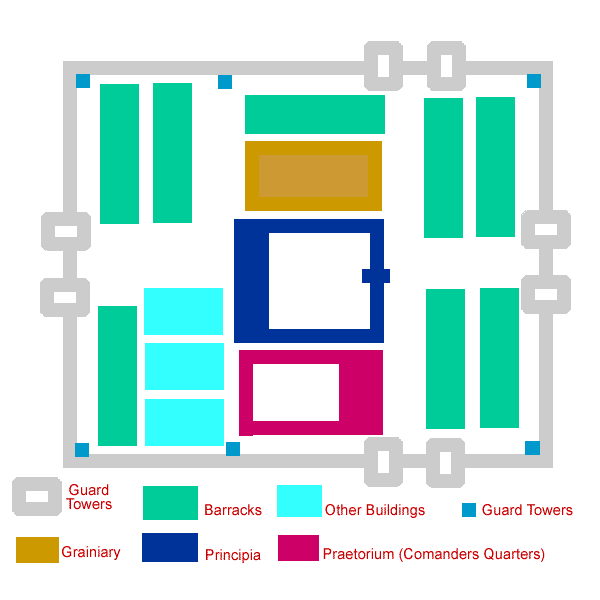A Roman Fort
The Romans developed a system of forts to guard their frontier. Some forts were large enough to hold an entire legion of six thousand men. The forts were developed in an organized design to allow the soldiers to have quick access to the surrounding walls. The same layout was used for the troops when they were on the move and made camp for the night. Around the forts, civilian settlements often developed. Even though soldiers were not allowed to marry, often girlfriends would live in the settlement near the fort.A fort would be set up with a large ditch around the outer edge. Dirt from the ditch was used to build a rampart. On the top of the rampart, a wooden wall would be built. If the Romans planned to make the fort permanent, a stone wall would be built to replace the wood. The gates would have guard towers on both sides. The Romans also dug deep holes and put in sharpened wooden stakes. They also would put sharp branches and timbers in a shallow ditch to make it difficult for infantry to approach the walls.
Specialized buildings were constructed inside of the forts. Barracks were built with eleven rooms to hold a century (group of eight men). One room was for the centurion, the other ten were for the ten contubeniums, groups of eight soldiers, which made up the century. The barracks for the best troop was near the main gate. In the middle of the fort were two large buildings the principia and the praetorium. The praetorium was the house for a unit's commander and his family. Generals and high commanders were allowed to marry in the Roman army. The principia was the building for the administrative offices of the fort and where the pay for the soldiers was stored. A fort would also have buildings blacksmiths, carpenters, butcher, shoemakers, storage for grains, and a stable for the horses. Outside of each fort, a Roman style bath was built. It was usually outside a forts walls because of the risk for fires.
The Romans built up walls, barriers and forts in areas where
they were most at risk. In England, Emperor Hadrian built a stone wall to keep
out people from the northern part of England. The wall took eight years to build
and totaled seventy-five miles in length. In central Europe, along the Rhine
and Danube rivers, the Romans built a barrier called the limes. The limes were
a series of wooden fences, ditches, towers, and forts constructed to protect
the northern empire. At one time there were over fifteen legions protecting
that dangerous part of the Roman frontier.
Roman Army Introduction | Army Structure | Auxiliaries | Army Daily Life
Army Formations | Roman Fort | Roman Navy | Siege Warfare


